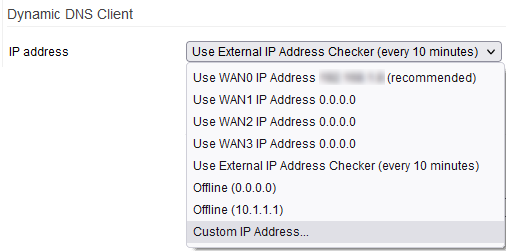User Tools
Sidebar
This is an old revision of the document!
Table of Contents
DDNS
The Dynamic DNS function allows you to have a private domain linked to a dynamic IP address. Periodically, as the IP address changes, a client module updates the binding between the domain name and IP address. In simple terms, Dynamic DNS allows you to have your own domain (or subdomain), and know the IP address bound to it on a regular basis.
This allows you to access your network device and its services from anywhere on the Internet, since you don't have to know the device's (changing) IP address. FreshTomato includes built-in DDNS clients for the most common DDNS providers.
Dynamic DNS Client
IP Address: This dropdown menu lets you select which IP address to bind to the domain address.
- Use WAN0 IP Address (YourWAN0Address) *
- This is the default, but you can choose from a custom choice below.
- Use WAN1 IP Address (Your WAN1Address)
- Use WAN2 IP Address (YourWAN2Address)
- Use WAN3 IP Address (Your WAN3Address)
- Use External IP Address Checker
- This is helpful if your device has no public IP address.
When selected, this checks every 10 minutes.
- Offline 0.0.0.0
- This sets the domain unreachable and points it to IP address 0.0.0.0
- Offline 10.1.1.1
- This sets the domain unreachable and points it to IP address 10.1.1.1
- Custom IP
- Here, you can set any DDNS domain you wish.
- However, this method is not dynamic.
Auto refresh every: Sets how often the domain-to-IP mapping is reconfirmed, even if the address didn't change.
You can configure up to two different DDNS domains. However, they will both be mapped to the same IP address, as above.
Dynamic DNS 1
Service: Specifies the name of the first built-in provider FreshTomato will use. If yours isn't listed, try the Custom URL option.
Most providers let you update the mapping IP by calling a specific URL linked to your account. Ask your DDNS provider for details on how to use the Custom URL. You can also try using DNS-O-MATIC, or simply change providers.
URL: Specifies the address of the first DDNS provider. Depending on the Provider selected, different fields appear.
These may include:
- Username
- Email address
- Password
- Token/
- Hostname
- MX
- Wildcard
- Save state when IP changes
Force next update: Enabling this triggers an update immediately after clicking Save. Use this with caution; some providers limit how often you can perform updates. Updating too frequently to your domain/account mapping might get you temporarily blocked.
Last IP Address: Displays the last IP address that the DDNS client used to send the update.
Last result: Performs a basic diagnostic to test your configuration works properly. You can map only one IP address, so this menu is currently not MultiWAN-aware.
Dynamic DNS 2
Service: identifies the second built-in DDNS provider to be used. If your provider isn't listed, you might try the Custom URL.Other options include trying DNS-O-MATIC or simply changing providers.
URL: is the address of the second DDNS provider, for better identification. Based on the Provider selected, you will see different fields, like username/password/token/hostname etcetera.
Force next update: This triggers an update as soon as you click Save. Note that some providers have a limitation on how many updates you can perform in a given period. If you perform too many updates your domain/account might get temporarily blocked.
Last IP Address: Provides you with the last IP address the second DDNS client used to send the update.
Last result: Performs a basic diagnostic to indicate if your configuration/account are correct. Since you can map only one IP address, this page is currently not MultiWAN-aware.


